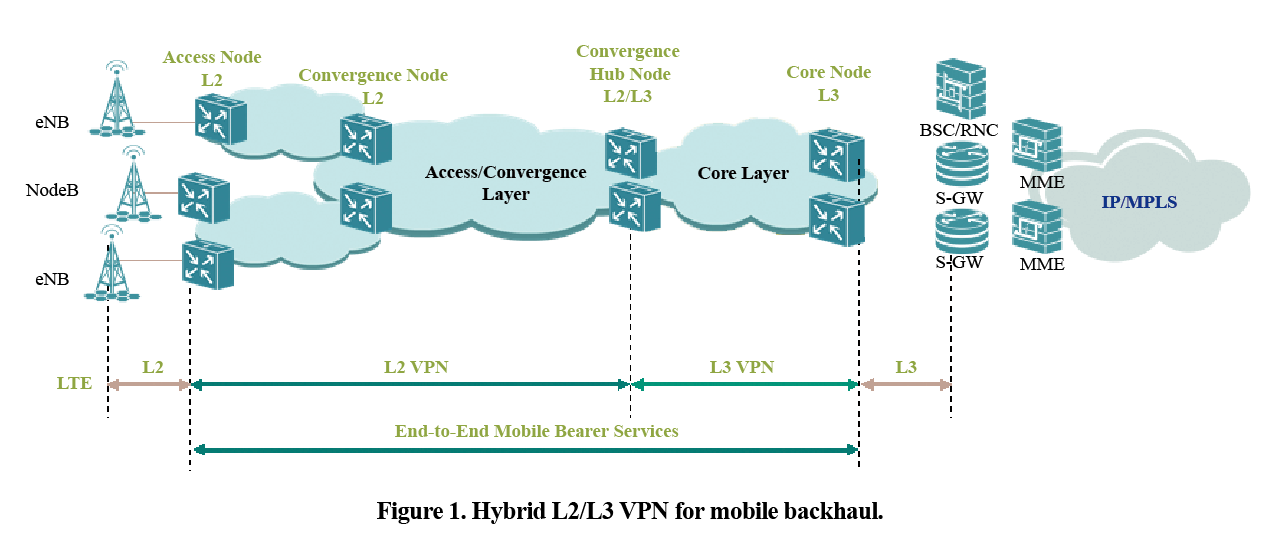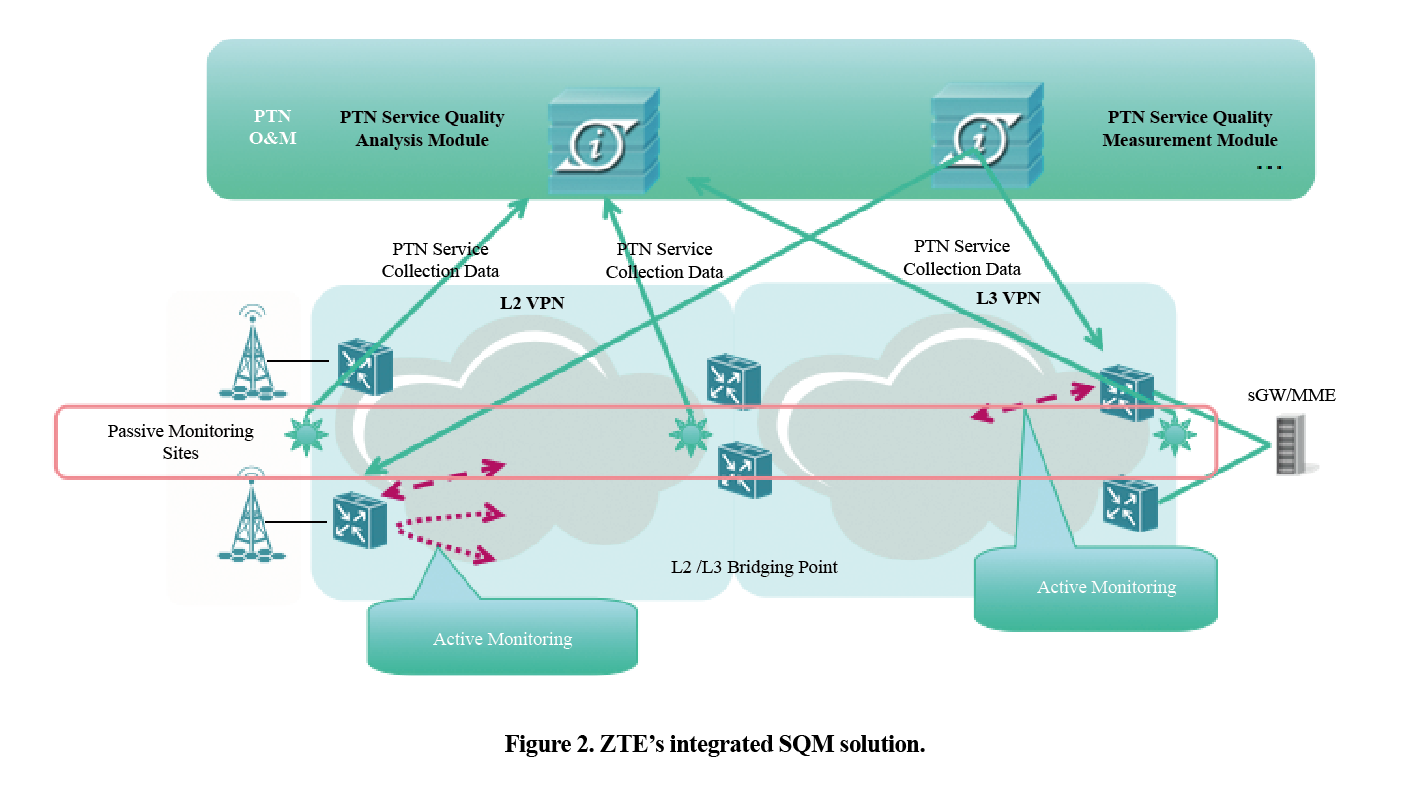Service Quality Management in PTN and IP RAN
 Service quality is key to operators remaining competitive. The effect of service bearer networks on service quality is the first issue an operator needs to consider in network O&M. As LTE services develop rapidly, service bearer networks have undergone great changes. Mobile backhaul networks have evolved from traditional TDM to packet-switched L2 VPN and then to hybrid L2-L3 VPNs. The mainstream technologies include PTN and IP RAN. With the evolution of network architecture, end-to-end service bearer paths have often been divided between multiple VPNs. This creates new challenges for network O&M (Fig. 1). First, an operator bearer network lacks end-to-end service quality monitoring and related visual O&M. Second, existing O&M techniques can hardly reflect the real service quality. Third, the division of bearer services between multiple VPNs seriously affects fault detection and location. All this gives rise to the development of service quality management (SQM).
Service quality is key to operators remaining competitive. The effect of service bearer networks on service quality is the first issue an operator needs to consider in network O&M. As LTE services develop rapidly, service bearer networks have undergone great changes. Mobile backhaul networks have evolved from traditional TDM to packet-switched L2 VPN and then to hybrid L2-L3 VPNs. The mainstream technologies include PTN and IP RAN. With the evolution of network architecture, end-to-end service bearer paths have often been divided between multiple VPNs. This creates new challenges for network O&M (Fig. 1). First, an operator bearer network lacks end-to-end service quality monitoring and related visual O&M. Second, existing O&M techniques can hardly reflect the real service quality. Third, the division of bearer services between multiple VPNs seriously affects fault detection and location. All this gives rise to the development of service quality management (SQM).

In ZTE’s integrated SQM solution, SQM functions are embedded in bearer devices for comprehensive quality management within the network management system. The SQM functions can also be combined with an advanced traffic analysis platform to provide integrated service-based traffic analysis tools. Both the bearer network management system and traffic analysis platform provide multi-layer, multi-domain hierarchical quality management and analysis to help operators build advanced networks. ZTE’s bearer devices support a wealth of SQM functions, including active Ping, TWAMP, RFC 2544/Y.1564, and HTTP/TCP/UDP/FTP connectivity measurement, as well as passive service performance statistics and SCTP protocol analysis. ZTE has been working with China Mobile to trial the SQM solution.
Major operators are viewing SQM with increasing importance and are attempting to improve service quality and O&M. As early as in 2014, China Mobile started researching SQM and focused on an index system and monitoring solutions for LTE service quality. China Telecom also raised SQM requirements for key accounts in 2014 that would support service performance measurement. With the rapid growth of pan-IP based services and the demands for network convergence, SQM is expected to be the basic requirement for service quality monitoring and O&M on operator networks in the future.
Considering IP-based service requirements and hybrid L2/L3 VPN architecture, an SQM solution can select monitoring technologies at L3 or above. The monitoring technologies at L3 are preferred for bearer networks. Standard technologies include L3 Ping (RFC 792/RFC 4443), BFD (RFC 5880), OWAMP/TWAMP (RFC 4656/RFC 5357), RFC 2544/Y.1564, and service performance sampling statistics. The L3 Ping provides simple connectivity detection; BFD provides universal connectivity detection; OWAMP/TWAMP provides connectivity, delay and jitter, and packet loss detection; RFC 2544/Y.1564 provides throughput, delay and jitter, and packet loss detection; and service performance sampling statistics provides statistical analysis of traffic flow and even business content.
Technically, SQM can be divided into three categories: active monitoring, passive monitoring, and combined active and passive monitoring. Now most monitoring technologies are active, including Ping, BFD, OWAMP/TWAMP and RFC 2544/Y.1564. Service performance sampling statistics belongs to passive monitoring. Active monitoring technologies are independent of traffic flow and can simulate traffic flow for quality monitoring. However, there may be a deviation between the monitored results and actual traffic. Passive monitoring technologies depend on traffic flow, and test results are reasonably accurate except that they are restricted by traffic flow. Combined active and passive monitoring technologies can integrate active and passive monitoring but lack a standard. From the technical perspective, active monitoring is most applicable to widespread standard deployments, while passive monitoring is used as a supplement for specific application scenarios.
An SQM solution can be deployed inside or outside the bearer devices. Deploying SQM functions inside the bearer devices means service quality monitoring technologies at L3 are built in the bearer equipment to comprehensively monitor the quality of both the bearer network and services. For external SQM functions, an additional SQM monitoring device needs to be deployed outside the bearer network. Although this simplifies the requirements for bearer devices, the deployment is complicated and costly, and integrated quality monitoring of both bearer networks and services is not possible. Therefore, deploying SQM functions inside the bearer devices is preferred by operators.
Through monitoring technologies at the L3 or above, the SQM solution directly monitors service quality and establishes a service-based quality indicator monitoring system. For IP-based services between LTE eNBs and xGWs, the solution monitors connectivity, delay, jitter, and packet loss of IP traffic flow in real time, and analyzes content of the IP traffic at the application layer, including the SCTP protocol and eNB traffic. By monitoring these service-based quality indicators, the solution can display service quality visually on the network management system in real time. When a fault occurs or performance deteriorates, an alarm is immediately generated and sent to maintenance personnel for troubleshooting.
The SQM solution can work with the traditional network O&M system to provide a highly efficient, integrated O&M. SQM monitors service-based quality indicators, while the traditional O&M monitors network-based quality indicators. In other words, SQM provides service-based KPIs whereas traditional O&M provides quality indicators based on network operation. The relationship between service quality indicators and operation quality indicators can be built gradually to optimize network quality according to service quality requirements. This facilitates O&M and optimizes network for better services.
